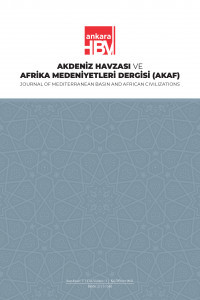HISTORY OF SRI LANKA-TÜRKIYE RELATIONS: FROM REMOTE ANTIQUITY TO THE 20TH CENTURY
Sri Lanka, famously called the ‘pearl of the Indian ocean’, is an island nation located in the tropics, lying off the southern tip of the Indian subcontinent. Given her favourable geostrategic position at the crossroads of major maritime routes, Sri Lanka, which is richly endowed with natural resources, has since time immemorial, been a major player in International trade. Known formerly as Serendib, Saheelan and Seylan among the Türks, Arabs and Persians, Sri Lanka, on which prophet Adam is believed to have descended when expelled from Paradise, has been immortalized in the works of numerous scholars including Mawlana Rūmī, and Katip Çelebi. Despite the fact that Süleyman the Magnificent's reign heralded the beginning of contacts between Sri Lanka and Ottoman Türkiye, official diplomatic relations were not established until Sulţan Abdül Aziz's reign in 1864. The Muslims of Si Lanka revered the Ottoman Sulţāns to the point of mentioning their names in the ‘khutba’, or sermon, during Friday prayers, and this age-old tradition continued until the reign of Sulţān Abdül Hamid II, after whom the first Muslim Boys’ School and a road in Sri Lanka are named. Unfortunately, limited research has been done on Sri Lanka-Türkiye historical relations, a subject that, despite its relevance, has received little attention. Therefore, this article, which examines Sri Lanka-Türkiye relations from ancient times to the twentieth Century, intends to enlighten the readers about the largely untold and unknown facets of our shared history and heritage. Given that Sri Lanka is one of Türkiye's important allies, raising awareness of this topic is timely, and pertinent.
Anahtar Kelimeler:
Ceylon, Ottoman Empire, Serendib, Sri Lanka, Türkiye
HISTORY OF SRI LANKA-TÜRKIYE RELATIONS: FROM REMOTE ANTIQUITY TO THE 20TH CENTURY
Sri Lanka, famously called the ‘pearl of the Indian ocean’, is an island nation located in the tropics, lying off the southern tip of the Indian subcontinent. Given her favourable geostrategic position at the crossroads of major maritime routes, Sri Lanka, which is richly endowed with natural resources, has since time immemorial, been a major player in International trade. Known formerly as Serendib, Saheelan and Seylan among the Türks, Arabs and Persians, Sri Lanka, on which prophet Adam is believed to have descended when expelled from Paradise, has been immortalized in the works of numerous scholars including Mawlana Rūmī, and Katip Çelebi. Despite the fact that Süleyman the Magnificent's reign heralded the beginning of contacts between Sri Lanka and Ottoman Türkiye, official diplomatic relations were not established until Sulţan Abdül Aziz's reign in 1864. The Muslims of Si Lanka revered the Ottoman Sulţāns to the point of mentioning their names in the ‘khutba’, or sermon, during Friday prayers, and this age-old tradition continued until the reign of Sulţān Abdül Hamid II, after whom the first Muslim Boys’ School and a road in Sri Lanka are named. Unfortunately, limited research has been done on Sri Lanka-Türkiye historical relations, a subject that, despite its relevance, has received little attention. Therefore, this article, which examines Sri Lanka-Türkiye relations from ancient times to the twentieth Century, intends to enlighten the readers about the largely untold and unknown facets of our shared history and heritage. Given that Sri Lanka is one of Türkiye's important allies, raising awareness of this topic is timely, and pertinent.
Keywords:
Ceylon, Ottoman Empire, Serendib, Sri Lanka, Türkiye,
___
- Akalın, D. (2015). OSMANLI DEVLETİ’NİN SON DÖNEMLERİNDE SEYLAN ADASI MÜSLÜMANLARI İLE MÜNASEBETLER . Belgi Dergisi , (10) , 1361-1392 . Retrieved from https://dergipark.org.tr/tr/pub/belgi/issue/35058/388871
- Abdül Azeez, I.L.M. (1900). The Moor’s Union and the Sultan’s Silver Jubilee. Colombo; Ganesha Printory Works.
- Bardakçı, M.N. (2008). Eğirdir Zeynî Zâviyesi ve Şeyh Mehmed Çelebi Divanı (Hızırnâme). Eğirdir: Si-nan Ofset.
- Barks, C. (2010). Rumi: The Big Red Book : The Great Masterpiece Celebrating Mystical Love and Friendship. New York: HarperCollins
- ISSN: 2717-7548
- Yayın Aralığı: Yılda 2 Sayı
- Başlangıç: 2019
- Yayıncı: Ankara Hacı Bayram Veli Üniversitesi
Sayıdaki Diğer Makaleler
Higher Education Crossing Borderlands: Experiences from Ethiopia and Somaliland
Muha Mohamoud OMAR, Mohamed OSMAN GUUDLE
CASTEL’E GÖRE FRANSA’DA ÜCRETLİLER TOPLUMUNDA BAZI DEĞİŞİMLER: ÖRSELENEN KOLEKTİF VE YENİ AYRIM
Bir Gezi/Anı ve Gözlem Kitabı Olarak “Afrika’ya Seyahatlerim”
TÜRKİYE’NİN EĞİTİM DİPLOMASİSİNDE TÜRKİYE MAARİF VAKFININ ROLÜ
Haktan KAPLAN, İbrahim ÇİMEN, Engin BALCI
İngilizce Öğretiminde İngilizce Öğrenenlerin İşaret Zamiri Hakkındaki Dil Farkındalıkları
ECONOMIC DIVERSIFICATION AS A TOOL FOR ECONOMIC RECOVERY IN ANGOLA
NİZÂR KABBÂNÎ’NİN ŞİİRLERİNDE SIRADIŞI KADIN TEMALARI
TUNUS CUMHURBAŞKANI KAYS SAİD'İN ANAYASAL POLİTİKASI: 2022 ANAYASA REFERANDUMU
